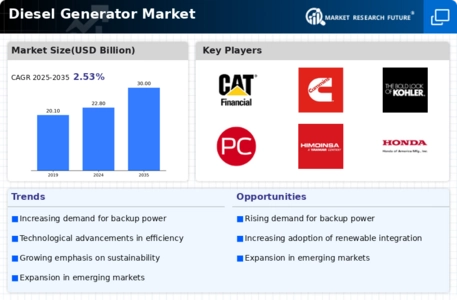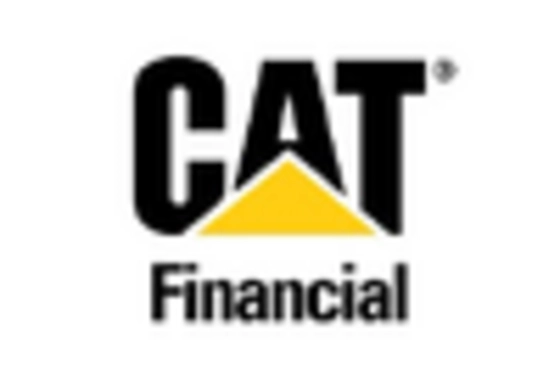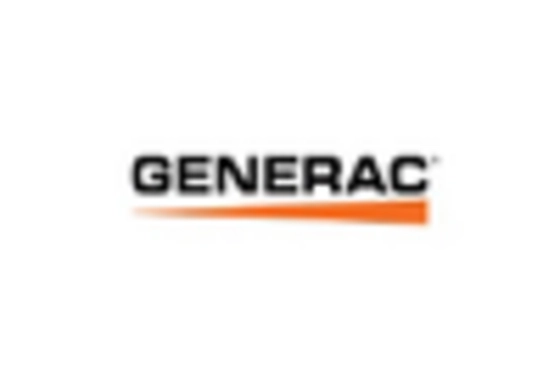-
\r\n6. DIESEL GENERATOR MARKET, BY APPLICATION (USD BILLION)
-
\r\n6.1. Residential \r\n6.2. Commercial
-
\r\n6.3. Industrial \r\n6.4.
-
Telecommunication \r\n6.5. Construction
-
\r\n7. DIESEL GENERATOR MARKET, BY FUEL TYPE (USD
-
BILLION) \r\n7.1. Light Diesel Oil \r\n7.2.
-
Heavy Diesel Oil \r\n7.3. Biodiesel \r\n7.4.
-
Natural Gas \r\n8. DIESEL GENERATOR MARKET,
-
BY POWER OUTPUT (USD BILLION) \r\n8.1. Up to 50 kVA
-
\r\n8.2. 51 kVA to 100 kVA \r\n8.3.
-
kVA to 300 kVA \r\n8.4. Above 300 kVA
-
\r\n9. DIESEL GENERATOR MARKET, BY COOLING SYSTEM
-
(USD BILLION) \r\n9.1. Air-Cooled \r\n9.2.
-
Liquid-Cooled \r\n9.3. Hybrid-Cooled
-
\r\n10. DIESEL GENERATOR MARKET, BY REGIONAL (USD
-
BILLION) \r\n10.1. North America \r\n10.1.1.
-
US \r\n10.1.2. Canada
-
\r\n10.2. Europe \r\n10.2.1.
-
Germany \r\n10.2.2. UK
-
\r\n10.2.3. France \r\n10.2.4.
-
Russia \r\n10.2.5. Italy
-
\r\n10.2.6. Spain \r\n10.2.7.
-
Rest of Europe \r\n10.3. APAC
-
\r\n10.3.1. China \r\n10.3.2.
-
India \r\n10.3.3. Japan
-
\r\n10.3.4. South Korea
-
\r\n10.3.5. Malaysia \r\n10.3.6.
-
Thailand \r\n10.3.7. Indonesia
-
\r\n10.3.8. Rest of APAC
-
\r\n10.4. South America \r\n10.4.1.
-
Brazil \r\n10.4.2. Mexico
-
\r\n10.4.3. Argentina
-
\r\n10.4.4. Rest of South America
-
\r\n10.5. MEA \r\n10.5.1. GCC Countries
-
\r\n10.5.2. South Africa
-
\r\n10.5.3. Rest of MEA
-
\r\n \r\n \r\n
-
\r\n11. COMPETITIVE LANDSCAPE \r\n11.1.
-
Overview \r\n11.2. Competitive Analysis
-
\r\n11.3. Market share Analysis \r\n11.4.
-
Major Growth Strategy in the Diesel Generator Market \r\n11.5.
-
Competitive Benchmarking \r\n11.6. Leading Players
-
in Terms of Number of Developments in the Diesel Generator Market \r\n11.7.
-
Key developments and growth strategies \r\n11.7.1. New Product
-
Launch/Service Deployment \r\n11.7.2.
-
Merger & Acquisitions \r\n11.7.3.
-
Joint Ventures \r\n11.8. Major
-
Players Financial Matrix \r\n11.8.1. Sales and Operating
-
Income \r\n11.8.2. Major Players R&D
-
Expenditure. 2023 \r\n12.
-
COMPANY PROFILES \r\n12.1. Kohler \r\n12.1.1.
-
Financial Overview \r\n12.1.2. Products
-
Offered \r\n12.1.3. Key Developments
-
\r\n12.1.4. SWOT Analysis
-
\r\n12.1.5. Key Strategies
-
\r\n12.2. Perkins \r\n12.2.1. Financial
-
Overview \r\n12.2.2. Products Offered
-
\r\n12.2.3. Key Developments
-
\r\n12.2.4. SWOT Analysis
-
\r\n12.2.5. Key Strategies \r\n12.3.
-
Himoinsa \r\n12.3.1. Financial Overview
-
\r\n12.3.2. Products Offered
-
\r\n12.3.3. Key Developments \r\n12.3.4.
-
SWOT Analysis \r\n12.3.5. Key Strategies
-
\r\n12.4. Honda \r\n12.4.1.
-
Financial Overview \r\n12.4.2. Products
-
Offered \r\n12.4.3. Key Developments
-
\r\n12.4.4. SWOT Analysis
-
\r\n12.4.5. Key Strategies
-
\r\n12.5. AJ Power \r\n12.5.1. Financial
-
Overview \r\n12.5.2. Products Offered
-
\r\n12.5.3. Key Developments
-
\r\n12.5.4. SWOT Analysis
-
\r\n12.5.5. Key Strategies \r\n12.6.
-
Caterpillar \r\n12.6.1. Financial Overview
-
\r\n12.6.2. Products Offered
-
\r\n12.6.3. Key Developments \r\n12.6.4.
-
SWOT Analysis \r\n12.6.5. Key Strategies
-
\r\n12.7. Generac \r\n12.7.1.
-
Financial Overview \r\n12.7.2. Products
-
Offered \r\n12.7.3. Key Developments
-
\r\n12.7.4. SWOT Analysis
-
\r\n12.7.5. Key Strategies
-
\r\n12.8. Yanmar \r\n12.8.1. Financial Overview
-
\r\n12.8.2. Products Offered
-
\r\n12.8.3. Key Developments
-
\r\n12.8.4. SWOT Analysis \r\n12.8.5.
-
Key Strategies \r\n12.9. Cummins
-
\r\n12.9.1. Financial Overview \r\n12.9.2.
-
Products Offered \r\n12.9.3. Key Developments
-
\r\n12.9.4. SWOT Analysis
-
\r\n12.9.5. Key Strategies
-
\r\n12.10. Atlas Copco \r\n12.10.1. Financial
-
Overview \r\n12.10.2. Products Offered
-
\r\n12.10.3. Key Developments
-
\r\n12.10.4. SWOT Analysis
-
\r\n12.10.5. Key Strategies \r\n12.11.
-
MTU Onsite Energy \r\n12.11.1. Financial Overview
-
\r\n12.11.2. Products Offered
-
\r\n12.11.3. Key Developments
-
\r\n12.11.4. SWOT Analysis \r\n12.11.5.
-
Key Strategies \r\n12.12. Toshiba
-
\r\n12.12.1. Financial Overview \r\n12.12.2.
-
Products Offered \r\n12.12.3. Key Developments
-
\r\n12.12.4. SWOT Analysis
-
\r\n12.12.5. Key Strategies
-
\r\n12.13. Wärtsilä \r\n12.13.1.
-
Financial Overview \r\n12.13.2. Products
-
Offered \r\n12.13.3. Key Developments
-
\r\n12.13.4. SWOT Analysis
-
\r\n12.13.5. Key Strategies
-
\r\n12.14. Briggs and Stratton \r\n12.14.1.
-
Financial Overview \r\n12.14.2. Products
-
Offered \r\n12.14.3. Key Developments
-
\r\n12.14.4. SWOT Analysis
-
\r\n12.14.5. Key Strategies
-
\r\n12.15. Doosan \r\n12.15.1. Financial
-
Overview \r\n12.15.2. Products Offered
-
\r\n12.15.3. Key Developments
-
\r\n12.15.4. SWOT Analysis
-
\r\n12.15.5. Key Strategies
-
\r\n13. APPENDIX \r\n13.1. References
-
\r\n13.2. Related Reports \r\nLIST
-
OF TABLES\r\n \r\nTABLE 1. LIST OF ASSUMPTIONS
-
\r\nTABLE 2. NORTH AMERICA DIESEL GENERATOR MARKET SIZE ESTIMATES
-
& FORECAST, BY APPLICATION, 2019-2035 (USD BILLIONS) \r\nTABLE
-
NORTH AMERICA DIESEL GENERATOR MARKET SIZE ESTIMATES & FORECAST, BY FUEL
-
TYPE, 2019-2035 (USD BILLIONS) \r\nTABLE 4. NORTH AMERICA
-
DIESEL GENERATOR MARKET SIZE ESTIMATES & FORECAST, BY POWER OUTPUT, 2019-2035
-
(USD BILLIONS) \r\nTABLE 5. NORTH AMERICA DIESEL GENERATOR
-
MARKET SIZE ESTIMATES & FORECAST, BY COOLING SYSTEM, 2019-2035 (USD BILLIONS)
-
\r\nTABLE 6. NORTH AMERICA DIESEL GENERATOR MARKET SIZE ESTIMATES
-
& FORECAST, BY REGIONAL, 2019-2035 (USD BILLIONS) \r\nTABLE
-
US DIESEL GENERATOR MARKET SIZE ESTIMATES & FORECAST, BY APPLICATION, 2019-2035
-
(USD BILLIONS) \r\nTABLE 8. US DIESEL GENERATOR MARKET SIZE
-
ESTIMATES & FORECAST, BY FUEL TYPE, 2019-2035 (USD BILLIONS) \r\nTABLE
-
US DIESEL GENERATOR MARKET SIZE ESTIMATES & FORECAST, BY POWER OUTPUT, 2019-2035
-
(USD BILLIONS) \r\nTABLE 10. US DIESEL GENERATOR MARKET SIZE
-
ESTIMATES & FORECAST, BY COOLING SYSTEM, 2019-2035 (USD BILLIONS) \r\nTABLE
-
US DIESEL GENERATOR MARKET SIZE ESTIMATES & FORECAST, BY REGIONAL, 2019-2035
-
(USD BILLIONS) \r\nTABLE 12. CANADA DIESEL GENERATOR MARKET
-
SIZE ESTIMATES & FORECAST, BY APPLICATION, 2019-2035 (USD BILLIONS) \r\nTABLE
-
CANADA DIESEL GENERATOR MARKET SIZE ESTIMATES & FORECAST, BY FUEL TYPE,
-
MARKET SIZE ESTIMATES & FORECAST, BY POWER OUTPUT, 2019-2035 (USD BILLIONS)
-
\r\nTABLE 15. CANADA DIESEL GENERATOR MARKET SIZE ESTIMATES &
-
FORECAST, BY COOLING SYSTEM, 2019-2035 (USD BILLIONS) \r\nTABLE
-
CANADA DIESEL GENERATOR MARKET SIZE ESTIMATES & FORECAST, BY REGIONAL, 2019-2035
-
(USD BILLIONS) \r\nTABLE 17. EUROPE DIESEL GENERATOR MARKET
-
SIZE ESTIMATES & FORECAST, BY APPLICATION, 2019-2035 (USD BILLIONS) \r\nTABLE
-
EUROPE DIESEL GENERATOR MARKET SIZE ESTIMATES & FORECAST, BY FUEL TYPE,
-
MARKET SIZE ESTIMATES & FORECAST, BY POWER OUTPUT, 2019-2035 (USD BILLIONS)
-
\r\nTABLE 20. EUROPE DIESEL GENERATOR MARKET SIZE ESTIMATES &
-
FORECAST, BY COOLING SYSTEM, 2019-2035 (USD BILLIONS) \r\nTABLE
-
EUROPE DIESEL GENERATOR MARKET SIZE ESTIMATES & FORECAST, BY REGIONAL, 2019-2035
-
(USD BILLIONS) \r\nTABLE 22. GERMANY DIESEL GENERATOR MARKET
-
SIZE ESTIMATES & FORECAST, BY APPLICATION, 2019-2035 (USD BILLIONS) \r\nTABLE
-
GERMANY DIESEL GENERATOR MARKET SIZE ESTIMATES & FORECAST, BY FUEL TYPE,
-
MARKET SIZE ESTIMATES & FORECAST, BY POWER OUTPUT, 2019-2035 (USD BILLIONS)
-
\r\nTABLE 25. GERMANY DIESEL GENERATOR MARKET SIZE ESTIMATES &
-
FORECAST, BY COOLING SYSTEM, 2019-2035 (USD BILLIONS) \r\nTABLE
-
GERMANY DIESEL GENERATOR MARKET SIZE ESTIMATES & FORECAST, BY REGIONAL,
-
MARKET SIZE ESTIMATES & FORECAST, BY APPLICATION, 2019-2035 (USD BILLIONS)
-
\r\nTABLE 28. UK DIESEL GENERATOR MARKET SIZE ESTIMATES & FORECAST,
-
BY FUEL TYPE, 2019-2035 (USD BILLIONS) \r\nTABLE 29. UK DIESEL
-
GENERATOR MARKET SIZE ESTIMATES & FORECAST, BY POWER OUTPUT, 2019-2035 (USD
-
BILLIONS) \r\nTABLE 30. UK DIESEL GENERATOR MARKET SIZE ESTIMATES
-
& FORECAST, BY COOLING SYSTEM, 2019-2035 (USD BILLIONS) \r\nTABLE
-
UK DIESEL GENERATOR MARKET SIZE ESTIMATES & FORECAST, BY REGIONAL, 2019-2035
-
(USD BILLIONS) \r\nTABLE 32. FRANCE DIESEL GENERATOR MARKET
-
SIZE ESTIMATES & FORECAST, BY APPLICATION, 2019-2035 (USD BILLIONS) \r\nTABLE
-
FRANCE DIESEL GENERATOR MARKET SIZE ESTIMATES & FORECAST, BY FUEL TYPE,
-
MARKET SIZE ESTIMATES & FORECAST, BY POWER OUTPUT, 2019-2035 (USD BILLIONS)
-
\r\nTABLE 35. FRANCE DIESEL GENERATOR MARKET SIZE ESTIMATES &
-
FORECAST, BY COOLING SYSTEM, 2019-2035 (USD BILLIONS) \r\nTABLE
-
FRANCE DIESEL GENERATOR MARKET SIZE ESTIMATES & FORECAST, BY REGIONAL, 2019-2035
-
(USD BILLIONS) \r\nTABLE 37. RUSSIA DIESEL GENERATOR MARKET
-
SIZE ESTIMATES & FORECAST, BY APPLICATION, 2019-2035 (USD BILLIONS) \r\nTABLE
-
RUSSIA DIESEL GENERATOR MARKET SIZE ESTIMATES & FORECAST, BY FUEL TYPE,
-
MARKET SIZE ESTIMATES & FORECAST, BY POWER OUTPUT, 2019-2035 (USD BILLIONS)
-
\r\nTABLE 40. RUSSIA DIESEL GENERATOR MARKET SIZE ESTIMATES &
-
FORECAST, BY COOLING SYSTEM, 2019-2035 (USD BILLIONS) \r\nTABLE
-
RUSSIA DIESEL GENERATOR MARKET SIZE ESTIMATES & FORECAST, BY REGIONAL, 2019-2035
-
(USD BILLIONS) \r\nTABLE 42. ITALY DIESEL GENERATOR MARKET
-
SIZE ESTIMATES & FORECAST, BY APPLICATION, 2019-2035 (USD BILLIONS) \r\nTABLE
-
ITALY DIESEL GENERATOR MARKET SIZE ESTIMATES & FORECAST, BY FUEL TYPE, 2019-2035
-
(USD BILLIONS) \r\nTABLE 44. ITALY DIESEL GENERATOR MARKET
-
SIZE ESTIMATES & FORECAST, BY POWER OUTPUT, 2019-2035 (USD BILLIONS) \r\nTABLE
-
ITALY DIESEL GENERATOR MARKET SIZE ESTIMATES & FORECAST, BY COOLING SYSTEM,
-
MARKET SIZE ESTIMATES & FORECAST, BY REGIONAL, 2019-2035 (USD BILLIONS)
-
\r\nTABLE 47. SPAIN DIESEL GENERATOR MARKET SIZE ESTIMATES &
-
FORECAST, BY APPLICATION, 2019-2035 (USD BILLIONS) \r\nTABLE
-
SPAIN DIESEL GENERATOR MARKET SIZE ESTIMATES & FORECAST, BY FUEL TYPE, 2019-2035
-
(USD BILLIONS) \r\nTABLE 49. SPAIN DIESEL GENERATOR MARKET
-
SIZE ESTIMATES & FORECAST, BY POWER OUTPUT, 2019-2035 (USD BILLIONS) \r\nTABLE
-
SPAIN DIESEL GENERATOR MARKET SIZE ESTIMATES & FORECAST, BY COOLING SYSTEM,
-
MARKET SIZE ESTIMATES & FORECAST, BY REGIONAL, 2019-2035 (USD BILLIONS)
-
\r\nTABLE 52. REST OF EUROPE DIESEL GENERATOR MARKET SIZE ESTIMATES
-
& FORECAST, BY APPLICATION, 2019-2035 (USD BILLIONS) \r\nTABLE
-
REST OF EUROPE DIESEL GENERATOR MARKET SIZE ESTIMATES & FORECAST, BY FUEL
-
TYPE, 2019-2035 (USD BILLIONS) \r\nTABLE 54. REST OF EUROPE
-
DIESEL GENERATOR MARKET SIZE ESTIMATES & FORECAST, BY POWER OUTPUT, 2019-2035
-
(USD BILLIONS) \r\nTABLE 55. REST OF EUROPE DIESEL GENERATOR
-
MARKET SIZE ESTIMATES & FORECAST, BY COOLING SYSTEM, 2019-2035 (USD BILLIONS)
-
\r\nTABLE 56. REST OF EUROPE DIESEL GENERATOR MARKET SIZE ESTIMATES
-
& FORECAST, BY REGIONAL, 2019-2035 (USD BILLIONS) \r\nTABLE
-
APAC DIESEL GENERATOR MARKET SIZE ESTIMATES & FORECAST, BY APPLICATION,
-
MARKET SIZE ESTIMATES & FORECAST, BY FUEL TYPE, 2019-2035 (USD BILLIONS)
-
\r\nTABLE 59. APAC DIESEL GENERATOR MARKET SIZE ESTIMATES &
-
FORECAST, BY POWER OUTPUT, 2019-2035 (USD BILLIONS) \r\nTABLE
-
APAC DIESEL GENERATOR MARKET SIZE ESTIMATES & FORECAST, BY COOLING SYSTEM,
-
MARKET SIZE ESTIMATES & FORECAST, BY REGIONAL, 2019-2035 (USD BILLIONS)
-
\r\nTABLE 62. CHINA DIESEL GENERATOR MARKET SIZE ESTIMATES &
-
FORECAST, BY APPLICATION, 2019-2035 (USD BILLIONS) \r\nTABLE
-
CHINA DIESEL GENERATOR MARKET SIZE ESTIMATES & FORECAST, BY FUEL TYPE, 2019-2035
-
(USD BILLIONS) \r\nTABLE 64. CHINA DIESEL GENERATOR MARKET
-
SIZE ESTIMATES & FORECAST, BY POWER OUTPUT, 2019-2035 (USD BILLIONS) \r\nTABLE
-
CHINA DIESEL GENERATOR MARKET SIZE ESTIMATES & FORECAST, BY COOLING SYSTEM,
-
MARKET SIZE ESTIMATES & FORECAST, BY REGIONAL, 2019-2035 (USD BILLIONS)
-
\r\nTABLE 67. INDIA DIESEL GENERATOR MARKET SIZE ESTIMATES &
-
FORECAST, BY APPLICATION, 2019-2035 (USD BILLIONS) \r\nTABLE
-
INDIA DIESEL GENERATOR MARKET SIZE ESTIMATES & FORECAST, BY FUEL TYPE, 2019-2035
-
(USD BILLIONS) \r\nTABLE 69. INDIA DIESEL GENERATOR MARKET
-
SIZE ESTIMATES & FORECAST, BY POWER OUTPUT, 2019-2035 (USD BILLIONS) \r\nTABLE
-
INDIA DIESEL GENERATOR MARKET SIZE ESTIMATES & FORECAST, BY COOLING SYSTEM,
-
MARKET SIZE ESTIMATES & FORECAST, BY REGIONAL, 2019-2035 (USD BILLIONS)
-
\r\nTABLE 72. JAPAN DIESEL GENERATOR MARKET SIZE ESTIMATES &
-
FORECAST, BY APPLICATION, 2019-2035 (USD BILLIONS) \r\nTABLE
-
JAPAN DIESEL GENERATOR MARKET SIZE ESTIMATES & FORECAST, BY FUEL TYPE, 2019-2035
-
(USD BILLIONS) \r\nTABLE 74. JAPAN DIESEL GENERATOR MARKET
-
SIZE ESTIMATES & FORECAST, BY POWER OUTPUT, 2019-2035 (USD BILLIONS) \r\nTABLE
-
JAPAN DIESEL GENERATOR MARKET SIZE ESTIMATES & FORECAST, BY COOLING SYSTEM,
-
MARKET SIZE ESTIMATES & FORECAST, BY REGIONAL, 2019-2035 (USD BILLIONS)
-
\r\nTABLE 77. SOUTH KOREA DIESEL GENERATOR MARKET SIZE ESTIMATES
-
& FORECAST, BY APPLICATION, 2019-2035 (USD BILLIONS) \r\nTABLE
-
SOUTH KOREA DIESEL GENERATOR MARKET SIZE ESTIMATES & FORECAST, BY FUEL TYPE,
-
GENERATOR MARKET SIZE ESTIMATES & FORECAST, BY POWER OUTPUT, 2019-2035 (USD
-
BILLIONS) \r\nTABLE 80. SOUTH KOREA DIESEL GENERATOR MARKET
-
SIZE ESTIMATES & FORECAST, BY COOLING SYSTEM, 2019-2035 (USD BILLIONS)
-
\r\nTABLE 81. SOUTH KOREA DIESEL GENERATOR MARKET SIZE ESTIMATES
-
& FORECAST, BY REGIONAL, 2019-2035 (USD BILLIONS) \r\nTABLE
-
MALAYSIA DIESEL GENERATOR MARKET SIZE ESTIMATES & FORECAST, BY APPLICATION,
-
MARKET SIZE ESTIMATES & FORECAST, BY FUEL TYPE, 2019-2035 (USD BILLIONS)
-
\r\nTABLE 84. MALAYSIA DIESEL GENERATOR MARKET SIZE ESTIMATES &
-
FORECAST, BY POWER OUTPUT, 2019-2035 (USD BILLIONS) \r\nTABLE
-
MALAYSIA DIESEL GENERATOR MARKET SIZE ESTIMATES & FORECAST, BY COOLING SYSTEM,
-
MARKET SIZE ESTIMATES & FORECAST, BY REGIONAL, 2019-2035 (USD BILLIONS)
-
\r\nTABLE 87. THAILAND DIESEL GENERATOR MARKET SIZE ESTIMATES &
-
FORECAST, BY APPLICATION, 2019-2035 (USD BILLIONS) \r\nTABLE
-
THAILAND DIESEL GENERATOR MARKET SIZE ESTIMATES & FORECAST, BY FUEL TYPE,
-
MARKET SIZE ESTIMATES & FORECAST, BY POWER OUTPUT, 2019-2035 (USD BILLIONS)
-
\r\nTABLE 90. THAILAND DIESEL GENERATOR MARKET SIZE ESTIMATES &
-
FORECAST, BY COOLING SYSTEM, 2019-2035 (USD BILLIONS) \r\nTABLE
-
THAILAND DIESEL GENERATOR MARKET SIZE ESTIMATES & FORECAST, BY REGIONAL,
-
MARKET SIZE ESTIMATES & FORECAST, BY APPLICATION, 2019-2035 (USD BILLIONS)
-
\r\nTABLE 93. INDONESIA DIESEL GENERATOR MARKET SIZE ESTIMATES
-
& FORECAST, BY FUEL TYPE, 2019-2035 (USD BILLIONS) \r\nTABLE
-
INDONESIA DIESEL GENERATOR MARKET SIZE ESTIMATES & FORECAST, BY POWER OUTPUT,
-
MARKET SIZE ESTIMATES & FORECAST, BY COOLING SYSTEM, 2019-2035 (USD BILLIONS)
-
\r\nTABLE 96. INDONESIA DIESEL GENERATOR MARKET SIZE ESTIMATES
-
& FORECAST, BY REGIONAL, 2019-2035 (USD BILLIONS) \r\nTABLE
-
REST OF APAC DIESEL GENERATOR MARKET SIZE ESTIMATES & FORECAST, BY APPLICATION,
-
GENERATOR MARKET SIZE ESTIMATES & FORECAST, BY FUEL TYPE, 2019-2035 (USD BILLIONS)
-
\r\nTABLE 99. REST OF APAC DIESEL GENERATOR MARKET SIZE ESTIMATES
-
& FORECAST, BY POWER OUTPUT, 2019-2035 (USD BILLIONS) \r\nTABLE
-
REST OF APAC DIESEL GENERATOR MARKET SIZE ESTIMATES & FORECAST, BY COOLING
-
SYSTEM, 2019-2035 (USD BILLIONS) \r\nTABLE 101. REST OF APAC
-
DIESEL GENERATOR MARKET SIZE ESTIMATES & FORECAST, BY REGIONAL, 2019-2035 (USD
-
BILLIONS) \r\nTABLE 102. SOUTH AMERICA DIESEL GENERATOR MARKET
-
SIZE ESTIMATES & FORECAST, BY APPLICATION, 2019-2035 (USD BILLIONS) \r\nTABLE
-
SOUTH AMERICA DIESEL GENERATOR MARKET SIZE ESTIMATES & FORECAST, BY FUEL
-
TYPE, 2019-2035 (USD BILLIONS) \r\nTABLE 104. SOUTH AMERICA
-
DIESEL GENERATOR MARKET SIZE ESTIMATES & FORECAST, BY POWER OUTPUT, 2019-2035
-
(USD BILLIONS) \r\nTABLE 105. SOUTH AMERICA DIESEL GENERATOR
-
MARKET SIZE ESTIMATES & FORECAST, BY COOLING SYSTEM, 2019-2035 (USD BILLIONS)
-
\r\nTABLE 106. SOUTH AMERICA DIESEL GENERATOR MARKET SIZE ESTIMATES
-
& FORECAST, BY REGIONAL, 2019-2035 (USD BILLIONS) \r\nTABLE
-
BRAZIL DIESEL GENERATOR MARKET SIZE ESTIMATES & FORECAST, BY APPLICATION,
-
MARKET SIZE ESTIMATES & FORECAST, BY FUEL TYPE, 2019-2035 (USD BILLIONS)
-
\r\nTABLE 109. BRAZIL DIESEL GENERATOR MARKET SIZE ESTIMATES &
-
FORECAST, BY POWER OUTPUT, 2019-2035 (USD BILLIONS) \r\nTABLE
-
BRAZIL DIESEL GENERATOR MARKET SIZE ESTIMATES & FORECAST, BY COOLING SYSTEM,
-
MARKET SIZE ESTIMATES & FORECAST, BY REGIONAL, 2019-2035 (USD BILLIONS)
-
\r\nTABLE 112. MEXICO DIESEL GENERATOR MARKET SIZE ESTIMATES &
-
FORECAST, BY APPLICATION, 2019-2035 (USD BILLIONS) \r\nTABLE
-
MEXICO DIESEL GENERATOR MARKET SIZE ESTIMATES & FORECAST, BY FUEL TYPE,
-
MARKET SIZE ESTIMATES & FORECAST, BY POWER OUTPUT, 2019-2035 (USD BILLIONS)
-
\r\nTABLE 115. MEXICO DIESEL GENERATOR MARKET SIZE ESTIMATES &
-
FORECAST, BY COOLING SYSTEM, 2019-2035 (USD BILLIONS) \r\nTABLE
-
MEXICO DIESEL GENERATOR MARKET SIZE ESTIMATES & FORECAST, BY REGIONAL,
-
GENERATOR MARKET SIZE ESTIMATES & FORECAST, BY APPLICATION, 2019-2035 (USD BILLIONS)
-
\r\nTABLE 118. ARGENTINA DIESEL GENERATOR MARKET SIZE ESTIMATES
-
& FORECAST, BY FUEL TYPE, 2019-2035 (USD BILLIONS) \r\nTABLE
-
ARGENTINA DIESEL GENERATOR MARKET SIZE ESTIMATES & FORECAST, BY POWER OUTPUT,
-
GENERATOR MARKET SIZE ESTIMATES & FORECAST, BY COOLING SYSTEM, 2019-2035 (USD
-
BILLIONS) \r\nTABLE 121. ARGENTINA DIESEL GENERATOR MARKET
-
SIZE ESTIMATES & FORECAST, BY REGIONAL, 2019-2035 (USD BILLIONS) \r\nTABLE
-
REST OF SOUTH AMERICA DIESEL GENERATOR MARKET SIZE ESTIMATES & FORECAST,
-
BY APPLICATION, 2019-2035 (USD BILLIONS) \r\nTABLE 123. REST
-
OF SOUTH AMERICA DIESEL GENERATOR MARKET SIZE ESTIMATES & FORECAST, BY FUEL
-
TYPE, 2019-2035 (USD BILLIONS) \r\nTABLE 124. REST OF SOUTH
-
AMERICA DIESEL GENERATOR MARKET SIZE ESTIMATES & FORECAST, BY POWER OUTPUT,
-
DIESEL GENERATOR MARKET SIZE ESTIMATES & FORECAST, BY COOLING SYSTEM, 2019-2035
-
(USD BILLIONS) \r\nTABLE 126. REST OF SOUTH AMERICA DIESEL
-
GENERATOR MARKET SIZE ESTIMATES & FORECAST, BY REGIONAL, 2019-2035 (USD BILLIONS)
-
\r\nTABLE 127. MEA DIESEL GENERATOR MARKET SIZE ESTIMATES &
-
FORECAST, BY APPLICATION, 2019-2035 (USD BILLIONS) \r\nTABLE
-
MEA DIESEL GENERATOR MARKET SIZE ESTIMATES & FORECAST, BY FUEL TYPE, 2019-2035
-
(USD BILLIONS) \r\nTABLE 129. MEA DIESEL GENERATOR MARKET
-
SIZE ESTIMATES & FORECAST, BY POWER OUTPUT, 2019-2035 (USD BILLIONS) \r\nTABLE
-
MEA DIESEL GENERATOR MARKET SIZE ESTIMATES & FORECAST, BY COOLING SYSTEM,
-
MARKET SIZE ESTIMATES & FORECAST, BY REGIONAL, 2019-2035 (USD BILLIONS)
-
\r\nTABLE 132. GCC COUNTRIES DIESEL GENERATOR MARKET SIZE ESTIMATES
-
& FORECAST, BY APPLICATION, 2019-2035 (USD BILLIONS) \r\nTABLE
-
GCC COUNTRIES DIESEL GENERATOR MARKET SIZE ESTIMATES & FORECAST, BY FUEL
-
TYPE, 2019-2035 (USD BILLIONS) \r\nTABLE 134. GCC COUNTRIES
-
DIESEL GENERATOR MARKET SIZE ESTIMATES & FORECAST, BY POWER OUTPUT, 2019-2035
-
(USD BILLIONS) \r\nTABLE 135. GCC COUNTRIES DIESEL GENERATOR
-
MARKET SIZE ESTIMATES & FORECAST, BY COOLING SYSTEM, 2019-2035 (USD BILLIONS)
-
\r\nTABLE 136. GCC COUNTRIES DIESEL GENERATOR MARKET SIZE ESTIMATES
-
& FORECAST, BY REGIONAL, 2019-2035 (USD BILLIONS) \r\nTABLE
-
SOUTH AFRICA DIESEL GENERATOR MARKET SIZE ESTIMATES & FORECAST, BY APPLICATION,
-
GENERATOR MARKET SIZE ESTIMATES & FORECAST, BY FUEL TYPE, 2019-2035 (USD BILLIONS)
-
\r\nTABLE 139. SOUTH AFRICA DIESEL GENERATOR MARKET SIZE ESTIMATES
-
& FORECAST, BY POWER OUTPUT, 2019-2035 (USD BILLIONS) \r\nTABLE
-
SOUTH AFRICA DIESEL GENERATOR MARKET SIZE ESTIMATES & FORECAST, BY COOLING
-
SYSTEM, 2019-2035 (USD BILLIONS) \r\nTABLE 141. SOUTH AFRICA
-
DIESEL GENERATOR MARKET SIZE ESTIMATES & FORECAST, BY REGIONAL, 2019-2035 (USD
-
BILLIONS) \r\nTABLE 142. REST OF MEA DIESEL GENERATOR MARKET
-
SIZE ESTIMATES & FORECAST, BY APPLICATION, 2019-2035 (USD BILLIONS) \r\nTABLE
-
REST OF MEA DIESEL GENERATOR MARKET SIZE ESTIMATES & FORECAST, BY FUEL
-
TYPE, 2019-2035 (USD BILLIONS) \r\nTABLE 144. REST OF MEA
-
DIESEL GENERATOR MARKET SIZE ESTIMATES & FORECAST, BY POWER OUTPUT, 2019-2035
-
(USD BILLIONS) \r\nTABLE 145. REST OF MEA DIESEL GENERATOR
-
MARKET SIZE ESTIMATES & FORECAST, BY COOLING SYSTEM, 2019-2035 (USD BILLIONS)
-
\r\nTABLE 146. REST OF MEA DIESEL GENERATOR MARKET SIZE ESTIMATES
-
& FORECAST, BY REGIONAL, 2019-2035 (USD BILLIONS) \r\nTABLE
-
PRODUCT LAUNCH/PRODUCT DEVELOPMENT/APPROVAL \r\nTABLE
-
ACQUISITION/PARTNERSHIP \r\n \r\n \r\n \r\n \r\n \r\n \r\n \r\n \r\n \r\n \r\n \r\n \r\n \r\n \r\n \r\n \r\n \r\n \r\n \r\n \r\n \r\n \r\n \r\n \r\n \r\n \r\n \r\n \r\n \r\nLIST
-
OF FIGURES\r\n \r\nFIGURE 1. MARKET SYNOPSIS \r\nFIGURE
-
NORTH AMERICA DIESEL GENERATOR MARKET ANALYSIS \r\nFIGURE 3.
-
US DIESEL GENERATOR MARKET ANALYSIS BY APPLICATION \r\nFIGURE 4.
-
US DIESEL GENERATOR MARKET ANALYSIS BY FUEL TYPE \r\nFIGURE 5. US
-
DIESEL GENERATOR MARKET ANALYSIS BY POWER OUTPUT \r\nFIGURE 6. US
-
DIESEL GENERATOR MARKET ANALYSIS BY COOLING SYSTEM \r\nFIGURE 7.
-
US DIESEL GENERATOR MARKET ANALYSIS BY REGIONAL \r\nFIGURE 8. CANADA
-
DIESEL GENERATOR MARKET ANALYSIS BY APPLICATION \r\nFIGURE 9. CANADA
-
DIESEL GENERATOR MARKET ANALYSIS BY FUEL TYPE \r\nFIGURE 10. CANADA
-
DIESEL GENERATOR MARKET ANALYSIS BY POWER OUTPUT \r\nFIGURE 11.
-
CANADA DIESEL GENERATOR MARKET ANALYSIS BY COOLING SYSTEM \r\nFIGURE
-
CANADA DIESEL GENERATOR MARKET ANALYSIS BY REGIONAL \r\nFIGURE
-
EUROPE DIESEL GENERATOR MARKET ANALYSIS \r\nFIGURE 14. GERMANY
-
DIESEL GENERATOR MARKET ANALYSIS BY APPLICATION \r\nFIGURE 15. GERMANY
-
DIESEL GENERATOR MARKET ANALYSIS BY FUEL TYPE \r\nFIGURE 16. GERMANY
-
DIESEL GENERATOR MARKET ANALYSIS BY POWER OUTPUT \r\nFIGURE 17.
-
GERMANY DIESEL GENERATOR MARKET ANALYSIS BY COOLING SYSTEM \r\nFIGURE
-
GERMANY DIESEL GENERATOR MARKET ANALYSIS BY REGIONAL \r\nFIGURE
-
UK DIESEL GENERATOR MARKET ANALYSIS BY APPLICATION \r\nFIGURE
-
UK DIESEL GENERATOR MARKET ANALYSIS BY FUEL TYPE \r\nFIGURE
-
UK DIESEL GENERATOR MARKET ANALYSIS BY POWER OUTPUT \r\nFIGURE
-
UK DIESEL GENERATOR MARKET ANALYSIS BY COOLING SYSTEM \r\nFIGURE
-
UK DIESEL GENERATOR MARKET ANALYSIS BY REGIONAL \r\nFIGURE 24.
-
FRANCE DIESEL GENERATOR MARKET ANALYSIS BY APPLICATION \r\nFIGURE
-
FRANCE DIESEL GENERATOR MARKET ANALYSIS BY FUEL TYPE \r\nFIGURE
-
FRANCE DIESEL GENERATOR MARKET ANALYSIS BY POWER OUTPUT \r\nFIGURE
-
FRANCE DIESEL GENERATOR MARKET ANALYSIS BY COOLING SYSTEM \r\nFIGURE
-
FRANCE DIESEL GENERATOR MARKET ANALYSIS BY REGIONAL \r\nFIGURE
-
RUSSIA DIESEL GENERATOR MARKET ANALYSIS BY APPLICATION \r\nFIGURE
-
RUSSIA DIESEL GENERATOR MARKET ANALYSIS BY FUEL TYPE \r\nFIGURE
-
RUSSIA DIESEL GENERATOR MARKET ANALYSIS BY POWER OUTPUT \r\nFIGURE
-
RUSSIA DIESEL GENERATOR MARKET ANALYSIS BY COOLING SYSTEM \r\nFIGURE
-
RUSSIA DIESEL GENERATOR MARKET ANALYSIS BY REGIONAL \r\nFIGURE
-
ITALY DIESEL GENERATOR MARKET ANALYSIS BY APPLICATION \r\nFIGURE
-
ITALY DIESEL GENERATOR MARKET ANALYSIS BY FUEL TYPE \r\nFIGURE
-
ITALY DIESEL GENERATOR MARKET ANALYSIS BY POWER OUTPUT \r\nFIGURE
-
ITALY DIESEL GENERATOR MARKET ANALYSIS BY COOLING SYSTEM \r\nFIGURE
-
ITALY DIESEL GENERATOR MARKET ANALYSIS BY REGIONAL \r\nFIGURE
-
SPAIN DIESEL GENERATOR MARKET ANALYSIS BY APPLICATION \r\nFIGURE
-
SPAIN DIESEL GENERATOR MARKET ANALYSIS BY FUEL TYPE \r\nFIGURE
-
SPAIN DIESEL GENERATOR MARKET ANALYSIS BY POWER OUTPUT \r\nFIGURE
-
SPAIN DIESEL GENERATOR MARKET ANALYSIS BY COOLING SYSTEM \r\nFIGURE
-
SPAIN DIESEL GENERATOR MARKET ANALYSIS BY REGIONAL \r\nFIGURE
-
REST OF EUROPE DIESEL GENERATOR MARKET ANALYSIS BY APPLICATION \r\nFIGURE
-
REST OF EUROPE DIESEL GENERATOR MARKET ANALYSIS BY FUEL TYPE \r\nFIGURE
-
REST OF EUROPE DIESEL GENERATOR MARKET ANALYSIS BY POWER OUTPUT \r\nFIGURE
-
REST OF EUROPE DIESEL GENERATOR MARKET ANALYSIS BY COOLING SYSTEM \r\nFIGURE
-
REST OF EUROPE DIESEL GENERATOR MARKET ANALYSIS BY REGIONAL \r\nFIGURE
-
APAC DIESEL GENERATOR MARKET ANALYSIS \r\nFIGURE 50. CHINA DIESEL
-
GENERATOR MARKET ANALYSIS BY APPLICATION \r\nFIGURE 51. CHINA DIESEL
-
GENERATOR MARKET ANALYSIS BY FUEL TYPE \r\nFIGURE 52. CHINA DIESEL
-
GENERATOR MARKET ANALYSIS BY POWER OUTPUT \r\nFIGURE 53. CHINA DIESEL
-
GENERATOR MARKET ANALYSIS BY COOLING SYSTEM \r\nFIGURE 54. CHINA
-
DIESEL GENERATOR MARKET ANALYSIS BY REGIONAL \r\nFIGURE 55. INDIA
-
DIESEL GENERATOR MARKET ANALYSIS BY APPLICATION \r\nFIGURE 56. INDIA
-
DIESEL GENERATOR MARKET ANALYSIS BY FUEL TYPE \r\nFIGURE 57. INDIA
-
DIESEL GENERATOR MARKET ANALYSIS BY POWER OUTPUT \r\nFIGURE 58.
-
INDIA DIESEL GENERATOR MARKET ANALYSIS BY COOLING SYSTEM \r\nFIGURE
-
INDIA DIESEL GENERATOR MARKET ANALYSIS BY REGIONAL \r\nFIGURE
-
JAPAN DIESEL GENERATOR MARKET ANALYSIS BY APPLICATION \r\nFIGURE
-
JAPAN DIESEL GENERATOR MARKET ANALYSIS BY FUEL TYPE \r\nFIGURE
-
JAPAN DIESEL GENERATOR MARKET ANALYSIS BY POWER OUTPUT \r\nFIGURE
-
JAPAN DIESEL GENERATOR MARKET ANALYSIS BY COOLING SYSTEM \r\nFIGURE
-
JAPAN DIESEL GENERATOR MARKET ANALYSIS BY REGIONAL \r\nFIGURE
-
SOUTH KOREA DIESEL GENERATOR MARKET ANALYSIS BY APPLICATION \r\nFIGURE
-
SOUTH KOREA DIESEL GENERATOR MARKET ANALYSIS BY FUEL TYPE \r\nFIGURE
-
SOUTH KOREA DIESEL GENERATOR MARKET ANALYSIS BY POWER OUTPUT \r\nFIGURE
-
SOUTH KOREA DIESEL GENERATOR MARKET ANALYSIS BY COOLING SYSTEM \r\nFIGURE
-
SOUTH KOREA DIESEL GENERATOR MARKET ANALYSIS BY REGIONAL \r\nFIGURE
-
MALAYSIA DIESEL GENERATOR MARKET ANALYSIS BY APPLICATION \r\nFIGURE
-
MALAYSIA DIESEL GENERATOR MARKET ANALYSIS BY FUEL TYPE \r\nFIGURE
-
MALAYSIA DIESEL GENERATOR MARKET ANALYSIS BY POWER OUTPUT \r\nFIGURE
-
MALAYSIA DIESEL GENERATOR MARKET ANALYSIS BY COOLING SYSTEM \r\nFIGURE
-
MALAYSIA DIESEL GENERATOR MARKET ANALYSIS BY REGIONAL \r\nFIGURE
-
THAILAND DIESEL GENERATOR MARKET ANALYSIS BY APPLICATION \r\nFIGURE
-
THAILAND DIESEL GENERATOR MARKET ANALYSIS BY FUEL TYPE \r\nFIGURE
-
THAILAND DIESEL GENERATOR MARKET ANALYSIS BY POWER OUTPUT \r\nFIGURE
-
THAILAND DIESEL GENERATOR MARKET ANALYSIS BY COOLING SYSTEM \r\nFIGURE
-
THAILAND DIESEL GENERATOR MARKET ANALYSIS BY REGIONAL \r\nFIGURE
-
INDONESIA DIESEL GENERATOR MARKET ANALYSIS BY APPLICATION \r\nFIGURE
-
INDONESIA DIESEL GENERATOR MARKET ANALYSIS BY FUEL TYPE \r\nFIGURE
-
INDONESIA DIESEL GENERATOR MARKET ANALYSIS BY POWER OUTPUT \r\nFIGURE
-
INDONESIA DIESEL GENERATOR MARKET ANALYSIS BY COOLING SYSTEM \r\nFIGURE
-
INDONESIA DIESEL GENERATOR MARKET ANALYSIS BY REGIONAL \r\nFIGURE
-
REST OF APAC DIESEL GENERATOR MARKET ANALYSIS BY APPLICATION \r\nFIGURE
-
REST OF APAC DIESEL GENERATOR MARKET ANALYSIS BY FUEL TYPE \r\nFIGURE
-
REST OF APAC DIESEL GENERATOR MARKET ANALYSIS BY POWER OUTPUT \r\nFIGURE
-
REST OF APAC DIESEL GENERATOR MARKET ANALYSIS BY COOLING SYSTEM \r\nFIGURE
-
REST OF APAC DIESEL GENERATOR MARKET ANALYSIS BY REGIONAL \r\nFIGURE
-
SOUTH AMERICA DIESEL GENERATOR MARKET ANALYSIS \r\nFIGURE 91.
-
BRAZIL DIESEL GENERATOR MARKET ANALYSIS BY APPLICATION \r\nFIGURE
-
BRAZIL DIESEL GENERATOR MARKET ANALYSIS BY FUEL TYPE \r\nFIGURE
-
BRAZIL DIESEL GENERATOR MARKET ANALYSIS BY POWER OUTPUT \r\nFIGURE
-
BRAZIL DIESEL GENERATOR MARKET ANALYSIS BY COOLING SYSTEM \r\nFIGURE
-
BRAZIL DIESEL GENERATOR MARKET ANALYSIS BY REGIONAL \r\nFIGURE
-
MEXICO DIESEL GENERATOR MARKET ANALYSIS BY APPLICATION \r\nFIGURE
-
MEXICO DIESEL GENERATOR MARKET ANALYSIS BY FUEL TYPE \r\nFIGURE
-
MEXICO DIESEL GENERATOR MARKET ANALYSIS BY POWER OUTPUT \r\nFIGURE
-
MEXICO DIESEL GENERATOR MARKET ANALYSIS BY COOLING SYSTEM \r\nFIGURE
-
MEXICO DIESEL GENERATOR MARKET ANALYSIS BY REGIONAL \r\nFIGURE
-
ARGENTINA DIESEL GENERATOR MARKET ANALYSIS BY APPLICATION \r\nFIGURE
-
ARGENTINA DIESEL GENERATOR MARKET ANALYSIS BY FUEL TYPE \r\nFIGURE
-
ARGENTINA DIESEL GENERATOR MARKET ANALYSIS BY POWER OUTPUT \r\nFIGURE
-
ARGENTINA DIESEL GENERATOR MARKET ANALYSIS BY COOLING SYSTEM \r\nFIGURE
-
ARGENTINA DIESEL GENERATOR MARKET ANALYSIS BY REGIONAL \r\nFIGURE
-
REST OF SOUTH AMERICA DIESEL GENERATOR MARKET ANALYSIS BY APPLICATION \r\nFIGURE
-
REST OF SOUTH AMERICA DIESEL GENERATOR MARKET ANALYSIS BY FUEL TYPE \r\nFIGURE
-
REST OF SOUTH AMERICA DIESEL GENERATOR MARKET ANALYSIS BY POWER OUTPUT \r\nFIGURE
-
REST OF SOUTH AMERICA DIESEL GENERATOR MARKET ANALYSIS BY COOLING SYSTEM \r\nFIGURE
-
REST OF SOUTH AMERICA DIESEL GENERATOR MARKET ANALYSIS BY REGIONAL \r\nFIGURE
-
MEA DIESEL GENERATOR MARKET ANALYSIS \r\nFIGURE 112. GCC COUNTRIES
-
DIESEL GENERATOR MARKET ANALYSIS BY APPLICATION \r\nFIGURE 113.
-
GCC COUNTRIES DIESEL GENERATOR MARKET ANALYSIS BY FUEL TYPE \r\nFIGURE
-
GCC COUNTRIES DIESEL GENERATOR MARKET ANALYSIS BY POWER OUTPUT \r\nFIGURE
-
GCC COUNTRIES DIESEL GENERATOR MARKET ANALYSIS BY COOLING SYSTEM \r\nFIGURE
-
GCC COUNTRIES DIESEL GENERATOR MARKET ANALYSIS BY REGIONAL \r\nFIGURE
-
SOUTH AFRICA DIESEL GENERATOR MARKET ANALYSIS BY APPLICATION \r\nFIGURE
-
SOUTH AFRICA DIESEL GENERATOR MARKET ANALYSIS BY FUEL TYPE \r\nFIGURE
-
SOUTH AFRICA DIESEL GENERATOR MARKET ANALYSIS BY POWER OUTPUT \r\nFIGURE
-
SOUTH AFRICA DIESEL GENERATOR MARKET ANALYSIS BY COOLING SYSTEM \r\nFIGURE
-
SOUTH AFRICA DIESEL GENERATOR MARKET ANALYSIS BY REGIONAL \r\nFIGURE
-
REST OF MEA DIESEL GENERATOR MARKET ANALYSIS BY APPLICATION \r\nFIGURE
-
REST OF MEA DIESEL GENERATOR MARKET ANALYSIS BY FUEL TYPE \r\nFIGURE
-
REST OF MEA DIESEL GENERATOR MARKET ANALYSIS BY POWER OUTPUT \r\nFIGURE
-
REST OF MEA DIESEL GENERATOR MARKET ANALYSIS BY COOLING SYSTEM \r\nFIGURE
-
REST OF MEA DIESEL GENERATOR MARKET ANALYSIS BY REGIONAL \r\nFIGURE
-
KEY BUYING CRITERIA OF DIESEL GENERATOR MARKET \r\nFIGURE 128.
-
RESEARCH PROCESS OF MRFR \r\nFIGURE 129. DRO ANALYSIS OF DIESEL
-
GENERATOR MARKET \r\nFIGURE 130. DRIVERS IMPACT ANALYSIS: DIESEL
-
GENERATOR MARKET \r\nFIGURE 131. RESTRAINTS IMPACT ANALYSIS: DIESEL
-
GENERATOR MARKET \r\nFIGURE 132. SUPPLY / VALUE CHAIN: DIESEL GENERATOR
-
MARKET \r\nFIGURE 133. DIESEL GENERATOR MARKET, BY APPLICATION,
-
BY FUEL TYPE, 2025 (% SHARE) \r\nFIGURE 136. DIESEL GENERATOR MARKET,
-
BY FUEL TYPE, 2019 TO 2035 (USD Billions) \r\nFIGURE 137. DIESEL
-
GENERATOR MARKET, BY POWER OUTPUT, 2025 (% SHARE) \r\nFIGURE 138.
-
DIESEL GENERATOR MARKET, BY POWER OUTPUT, 2019 TO 2035 (USD Billions) \r\nFIGURE
-
DIESEL GENERATOR MARKET, BY COOLING SYSTEM, 2025 (% SHARE) \r\nFIGURE
-
DIESEL GENERATOR MARKET, BY COOLING SYSTEM, 2019 TO 2035 (USD Billions) \r\nFIGURE
-
DIESEL GENERATOR MARKET, BY REGIONAL, 2025 (% SHARE) \r\nFIGURE
-
DIESEL GENERATOR MARKET, BY REGIONAL, 2019 TO 2035 (USD Billions) \r\nFIGURE
-
BENCHMARKING OF MAJOR COMPETITORS \r\n









Leave a Comment